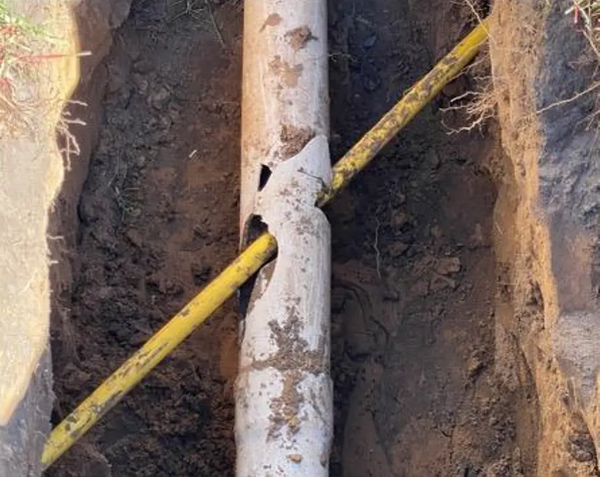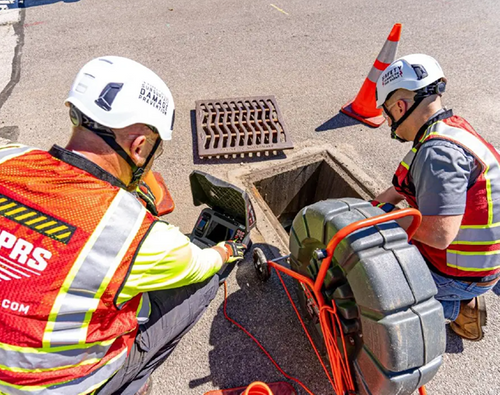How NASSCO-Certified GPRS Video Pipe Inspections Protect Water & Wastewater Systems from the Hidden Threat of Cross Bores
The most common cross bores are in sanitary and storm sewer lines, but they can also occur in water mains, electrical conduits, and the most dangerous version – gas line incursions.

Cross bores are a potentially deadly byproduct of installing utility lines via trenchless technology. GPRS Video Pipe Inspections can help locate these dangerous incursions before they cause injury, or worse.
“Cross bore mitigation is always our team’s biggest focus.” – Andy Jurski, GPRS Senior VPI Project Manager
Municipal water and wastewater systems form the backbone of any city or facility’s infrastructure, ensuring safe drinking water, sanitary waste disposal, and overall public health. However, a hidden danger threatens these networks: cross bores. These accidental utility intrusions can cause catastrophic failures, from sewer blockages to gas explosions, endangering residents and disrupting essential services.
Municipal water and wastewater managers, along with facilities directors, must take proactive steps to detect and mitigate cross bores before they cause damage. As trenchless installation methods become more common, municipalities must rely on advanced inspection technologies, like Video Pipe Inspection, to safeguard their underground infrastructure.
Understanding Cross Bores and Their Risks
Cross bores occur when directional drilling installs an underground utility that unintentionally pierces an existing utility line or pipe. The most common cross bores are in sanitary and storm sewer lines, but they can also occur in water mains, electrical conduits, and the most dangerous version – gas line incursions. Trenchless boring technologies, efficient but high-risk methods for laying new utilities without open trench excavation, are gaining momentum, which means more potential for cross bores. Because trenchless installation relies on blindly drilling through the soil, there is no immediate way to detect conflicts with buried infrastructure.
For municipal water and wastewater managers, cross bores present serious operational, environmental, and financial risks:
- Safety Threats: Cross bores involving gas or electrical lines can lead to hazardous leaks, fires, service interruptions, and even explosions. When maintenance crews unknowingly disturb cross-bored pipelines, the consequences can be deadly.
- Operational Impact: Blockages or pipeline damage from cross bores can disrupt water flow, affecting municipal water quality, pressure levels, and service reliability. Cross bores can cause enormous waste in water lines due to leaks that could go unknown for years. Wastewater systems may experience inefficiencies, infiltration/inflow, or compliance issues due to pipeline obstructions.
- Financial & Legal Consequences: Cross bore incidents can lead to expensive emergency repairs, fines, and liability disputes. Preventative inspections help municipalities avoid unexpected costs and legal challenges associated with infrastructure failures.
Case Study: The Devastating Consequences of an Undetected Cross Bore
The risks of cross bores extend beyond pipeline damage – they can result in life-threatening situations. The Eldridge family of Middletown, Ohio, experienced this firsthand. While a plumber attempted to clear a simple sewer blockage at their home, his equipment struck a gas line that had been inadvertently bored into the sewer. Within moments, the house erupted in flames.
Fortunately, everyone escaped safely. However, the explosion destroyed their home, leaving the family devastated. A post-incident inspection confirmed that a cross bore was responsible for the disaster: a mistake caused by a previous utility contractor that went undetected until disaster struck. Municipalities and facility managers must take preventative measures to ensure that similar tragedies do not occur in their communities.
How Municipal Leaders Can Prevent Cross Bores
Municipalities are increasingly adopting Video Pipe Inspections, CCTV crawler, push camera, and lateral line sewer assessments performed by certified professionals to help to mitigate cross bore risks. GPRS’ NASSCO-certified VPI Project Managers specialize in comprehensive sewer scopes using advanced technology to detect utility conflicts before they result in infrastructure failure.
The Video Pipe Inspection Process
GPRS deploys high-definition camera systems through sanitary, storm sewer, and lateral lines, ensuring that municipal and facilities managers receive detailed insights into underground conditions. These inspections provide critical data for risk mitigation:
- Pre-Installation Utility Mapping: Before trenchless work begins, a VPI report can confirm the precise location and integrity of underground water and wastewater pipes. This information can be made available to the utility contractors who install using directional boring to reduce the likelihood of accidental cross bores.
- Post-Installation Inspection: After trenchless utility lines are installed, a post-installation assessment is conducted to verify that no existing infrastructure was damaged, and pinpointing any cross bores that have occurred.
- Comprehensive Defect Documentation: Each video pipe inspection package from GPRS includes video footage, screenshots, and detailed descriptions of any defects, ranked by severity and geolocated for precise repair and maintenance planning.

GPRS’ NASSCO-certified Video Pipe Inspection Project Managers are trained to the highest standard possible and use only the most advanced equipment in our effort to eliminate all subsurface utility strikes.
The NASSCO Advantage in Municipal Utility Management
Municipal water and wastewater managers must rely on industry-recognized standards to ensure infrastructure reliability. The National Association of Sewer Service Companies (NASSCO) establishes best practices for underground pipeline assessment and maintenance.
GPRS’ VPI Project Managers undergo rigorous training through NASSCO’s Pipeline Assessment Certification Program (PACP), Lateral Assessment Certification Program (LACP), and Manhole Assessment Certification Program (MACP). Plus, all GPRS Project Managers are also certified in Subsurface Investigation Methodology (SIM). This ensures that our inspectors meet the highest standards for utility infrastructure evaluation.
With a 99.8% accuracy rating in utility locating, GPRS provides municipal leaders and facilities managers with the data they need to maintain safe and efficient underground systems.
Why Facilities Managers Must Take Action
Municipal water infrastructure is vital to public safety and operational efficiency. Facilities managers overseeing large-scale infrastructure projects – including hospitals, universities, and commercial buildings – must also prioritize cross bore prevention to avoid service disruptions and costly repairs.
By incorporating Video Pipe Inspections into routine maintenance procedures, facilities directors can ensure compliance, prevent unexpected pipeline failures, and safeguard occupants. The ability to identify and address underground utility conflicts before they escalate allows municipalities and facilities to maintain uninterrupted service, reduce liability risks, and enhance infrastructure resilience.
Secure Your City’s Infrastructure with GPRS
Municipal water and wastewater managers carry a significant responsibility in protecting underground sanitary and storm sewers from unforeseen hazards like cross bores. By conducting NASSCO-certified Video Pipe Inspections, especially pre and post-cross bore surveys, municipalities and facilities managers ensure that infrastructure remains safe, operational, and compliant with industry standards.
GPRS specializes in solutions to help mitigate risk and enhance operations and maintenance throughout the infrastructure life cycle. Our certified inspection teams help municipalities and facilities managers make informed decisions with high-accuracy data.
Let’s work together to Intelligently Visualize The Built World® and safeguard municipal infrastructure for future generations.
What can we help you visualize?
